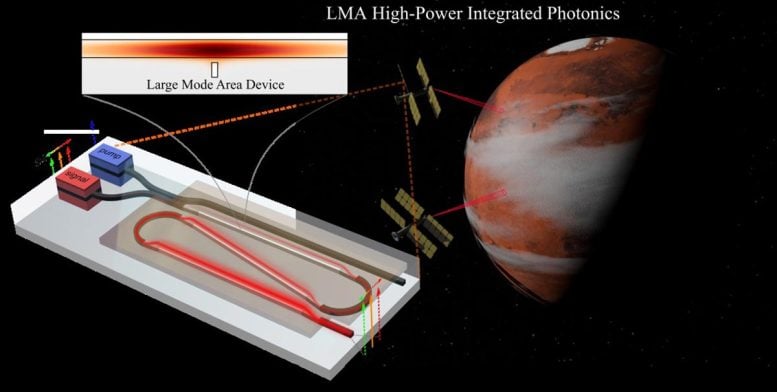博文
集成光子学达到里程碑:高功率可调谐激光器开辟新天地
||
集成光子学达到里程碑:高功率可调谐激光器开辟新天地
诸平
据《科学日报》(scitechdaily)网站2025年1月8日刊发的来自中国科学院长春光学精密机械与物理研究所Light出版中心(Light Publishing Center, Changchun Institute of Optics, Fine Mechanics And Physics, CAS)提供的消息,集成光子学达到里程碑:高功率可调谐激光器开辟新天地(Integrated Photonics Hits Milestone: High-Power Tunable Lasers Break New Ground)。
德国、荷兰和瑞士的研究人员合作,在硅光子学(silicon photonics)上创造了一种高功率可调谐激光器,使用LMA放大器达到近2 W。这一进步可能会彻底改变集成光子学(integrated photonics),在太空探索中有潜在的应用,在提高能力的同时降低卫星成本。相关研究结果于2025年1月2日已经在《光:科学与应用》(Light: Science & Applications)杂志网站发表——Neetesh Singh, Jan Lorenzen, Muharrem Kilinc, Kai Wang, Milan Sinobad, Henry Francis, Jose Carreira, Michael Geiselmann, Umit Demirbas, Mikhail Pergament, Sonia M. Garcia-Blanco, Franz X. Kärtner. Sub-2W tunable laser based on silicon photonics power amplifier. Light: Science & Applications, 2025, 14: 18. DOI: 10.1038/s41377-024-01681-1. Published: 2 January 2025. https://www.nature.com/articles/s41377-024-01681-1
参与此项研究的有来自德国电子同步加速器研究所自由电子激光科学中心(Center for Free-Electron Laser Science CFEL, Deutsches Elektronen-Synchrotron DESY, Hamburg, Germany)、荷兰特温特大学(University of Twente, 7500AE, Enschede, The Netherlands)、瑞士洛桑联邦理工学院创新园的LIGENTEC公司(LIGENTEC SA, EPFL Innovation Par L, Chemin de la Dent-d’Oche 1B, CH-1024, Ecublens, Switzerland)以及德国汉堡大学(Universität Hamburg, Jungiusstr. 9, Hamburg, Germany)的研究人员。
在当今世界,各种系统的尺寸不断减小,为高速数据中心和空间探索等应用集成了越来越小的组件。然而,由于集成光子学的进步,这种小型化和高密度集成的趋势已经大大降低了这些系统产生高信号功率的能力。传统上,高功率输出与较大的系统有关,例如光纤和固态平台,其物理尺寸允许更大的能量存储。
相比之下,微米到毫米级的系统,包括那些基于集成光子学的系统,其光能存储容量远低于大型的台式系统。因此,它们的发电能力本质上是有限的。
硅光子学对大功率信号产生的需求(Need for High-Power Signal Generation in Silicon Photonics)
为了实现高功能、可批量生产的硅光子学系统的大规模部署,并取代笨重的台式系统,基于硅光子学的激光器和放大器必须产生与台式系统相当的高功率信号。
最近,由尼泰斯·辛格博士(Dr. Neetesh Singh)和弗朗茨·卡特内尔教授(Prof. Franz Kärtner)领导的德国研究人员,展示了一种非常高功率的可调谐激光器,其输出功率接近2 W,这要归功于最近构想的硅光子学上的大模面积(large-mode-area简称LMA)集成波导放大器。
研究人员设想,这种设备可以在光子学领域产生破坏性影响,并可能允许集成光子学设备在各个领域大规模实施。
一个潜在的应用可能是,这种在长波长窗口工作的高功率可调谐激光器被部署在小型卫星上,以感知和绘制——通过激光雷达(LIDAR)等技术——外太空生命所必需的分子;例如,二氧化碳,水和氨。与传统的光纤或基于固态的系统相比,基于LMA硅光子学的高功率可调谐激光器将使系统尺寸、重量和成本降低几个数量级,从而实现之前无法实现的多个具有高度增强能力的高成本效益的太空任务。
这项研究得到了欧盟地平线2020框架计划{EU Horizon 2020 Framework Programme—Grant Agreement No.: 965124 (FEMTOCHIP)}和德国研究基金会{Deutsche Forschungsgemeinschaft (SP2111) contract number PACE:Ka908/10-1}的资助。
上述介绍,仅供参考。欲了解更多信息,敬请注意浏览原文或者相关报道。
High-power tunable lasers are intensely pursued due to their vast application potential such as in telecom, ranging, and molecular sensing. Integrated photonics, however, is usually considered not suitable for high-power applications mainly due to its small size which limits the energy storage capacity and, therefore, the output power. In the late 90s, to improve the beam quality and increase the stored energy, large-mode-area (LMA) fibers were introduced in which the optical mode area is substantially large. Such LMA fibers have transformed the high-power capability of fiber systems ever since. Introducing such an LMA technology at the chip-scale can play an equally disruptive role with high power signal generation from an integrated photonics system. To this end, in this work we demonstrate such a technology, and show a very high-power tunable laser with the help of a silicon photonics based LMA power amplifier. We show output power reaching 1.8 W over a tunability range of 60 nm, spanning from 1.83 µm to 1.89 µm, limited only by the seed laser. Such an integrated LMA device can be used to substantially increase the power of the existing integrated tunable lasers currently limited to a few tens of milliwatts. The power levels demonstrated here reach and surpass that of many benchtop systems which truly makes the silicon photonics based integrated LMA device poised towards mass deployment for high power applications without relying on benchtop systems.
https://blog.sciencenet.cn/blog-212210-1468100.html
上一篇:甜的危险:含糖饮料如何在全球范围内引发数百万新的糖尿病和心脏病病例
下一篇:肺移植领域的里程碑:体外光移植术改善了排斥反应和感染率
